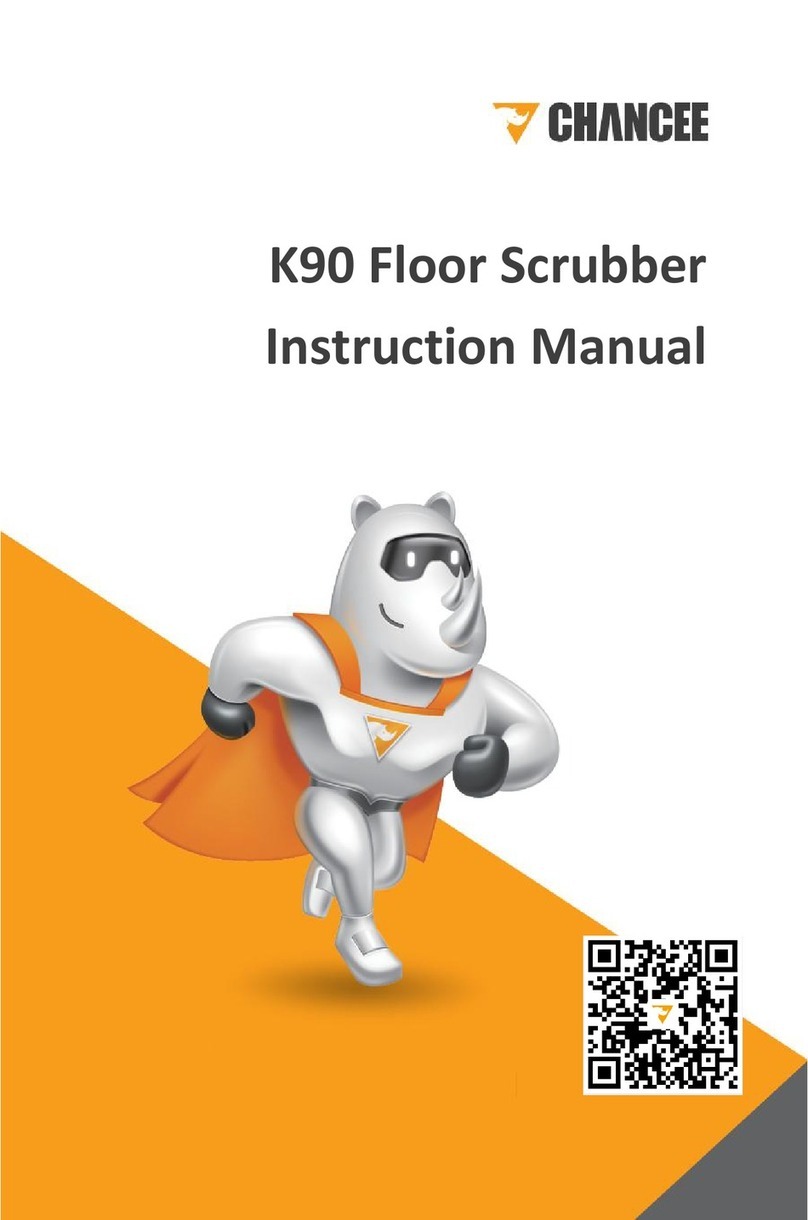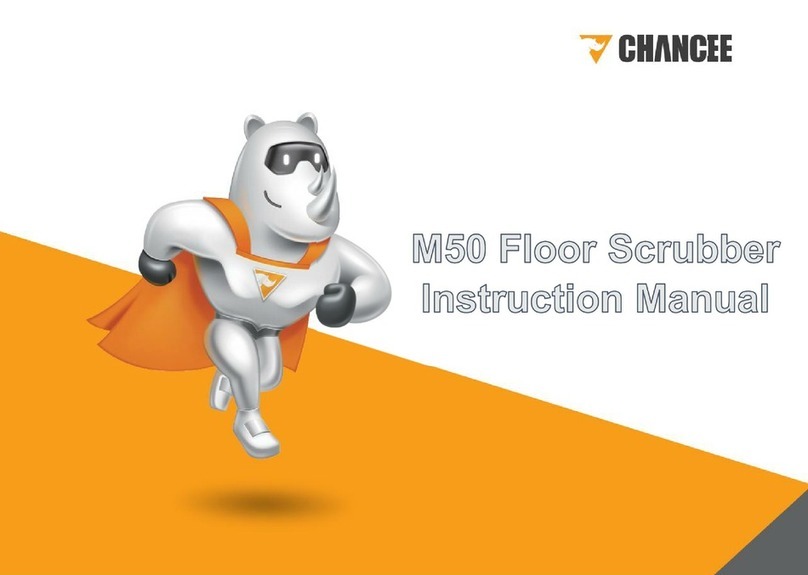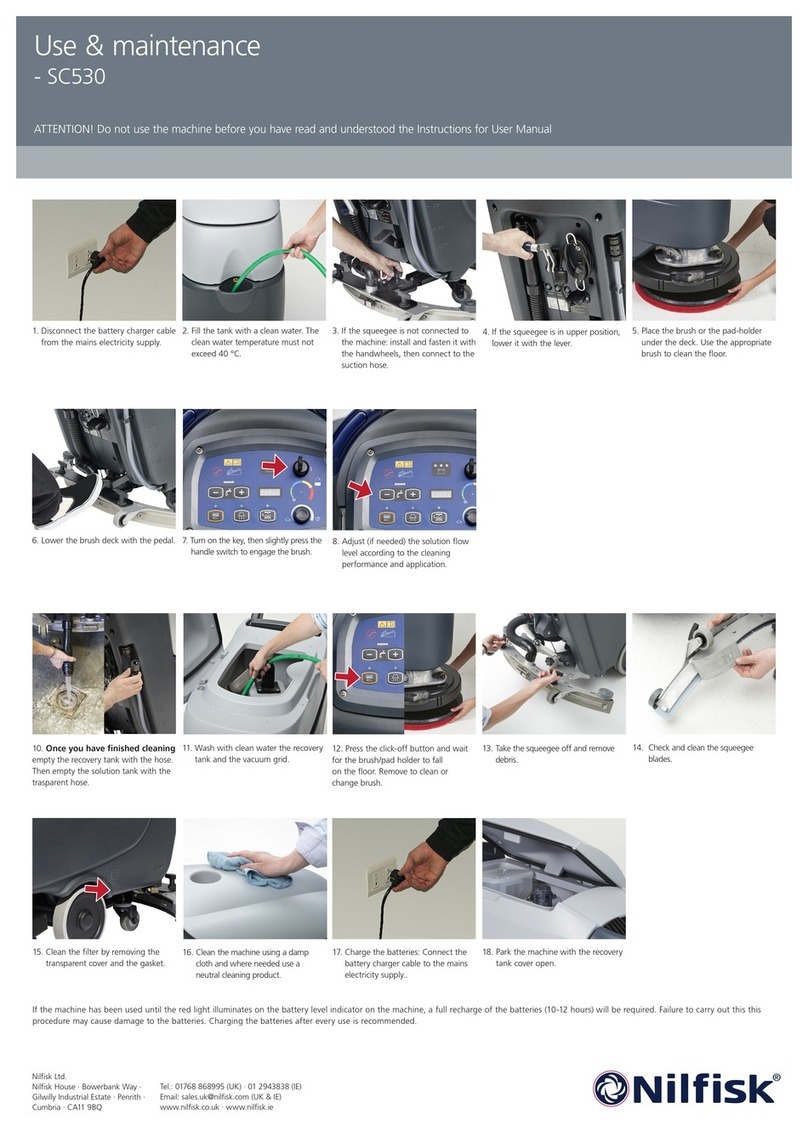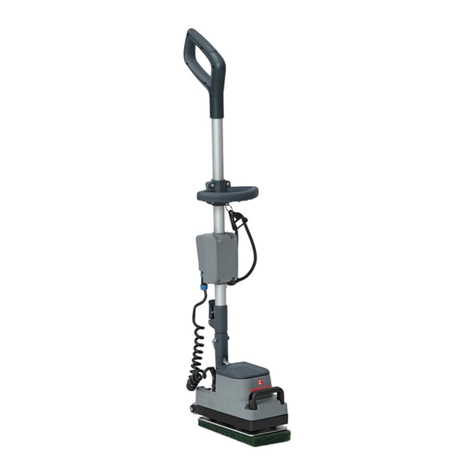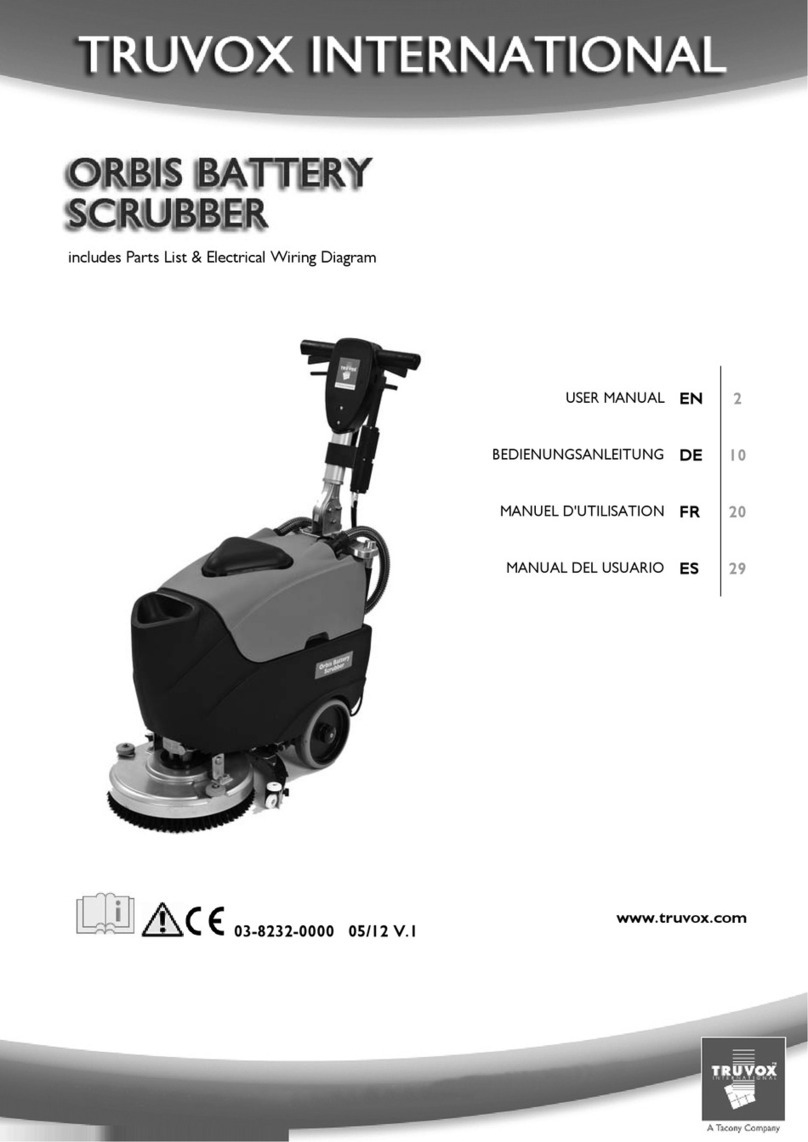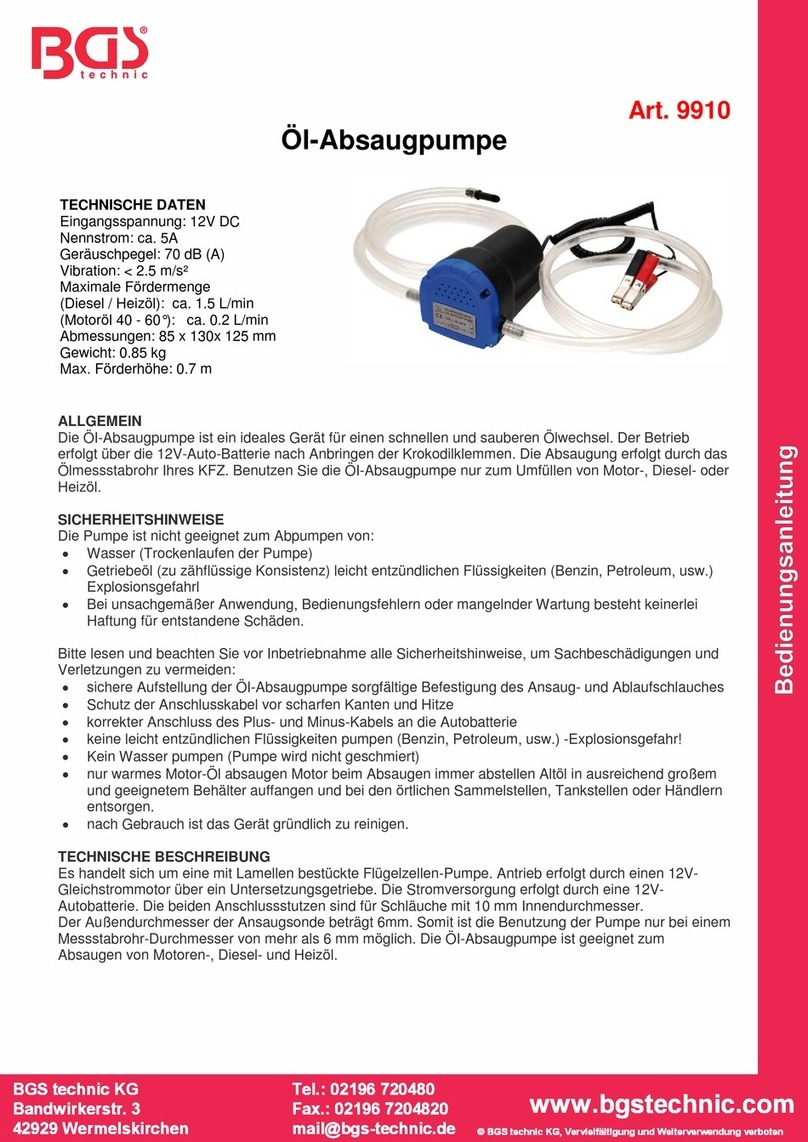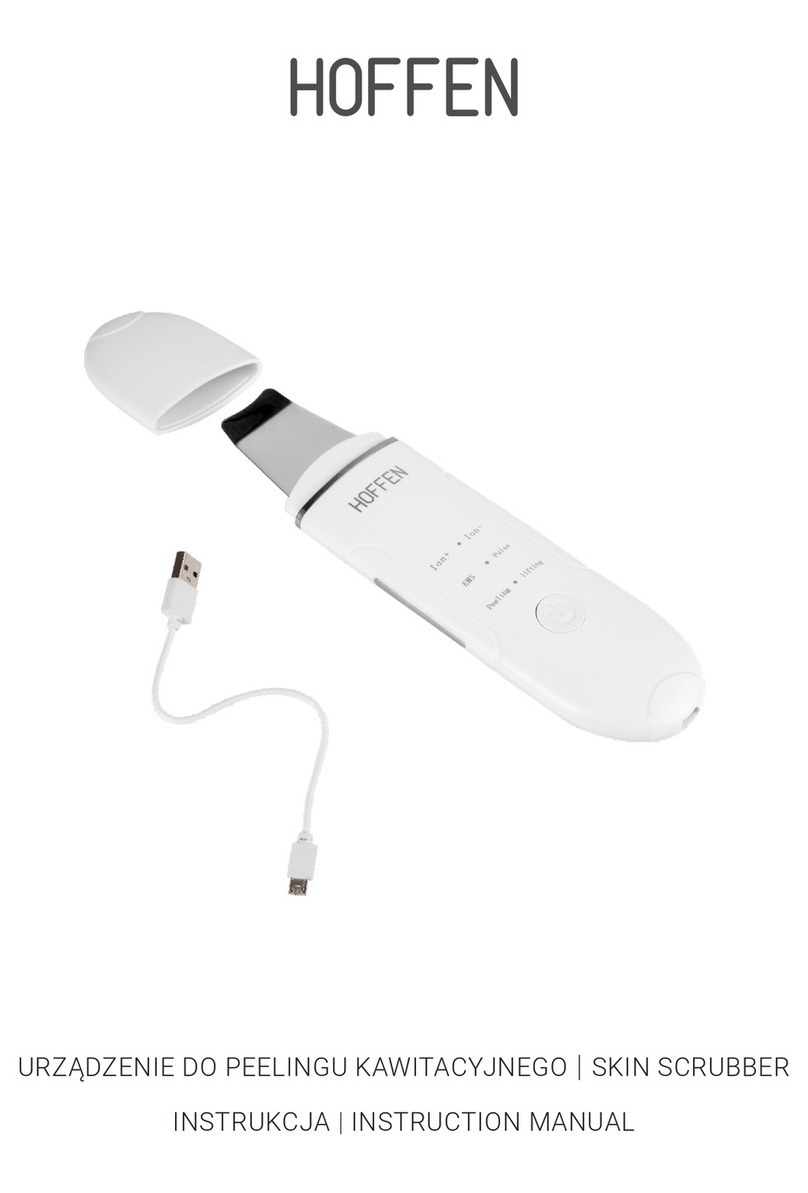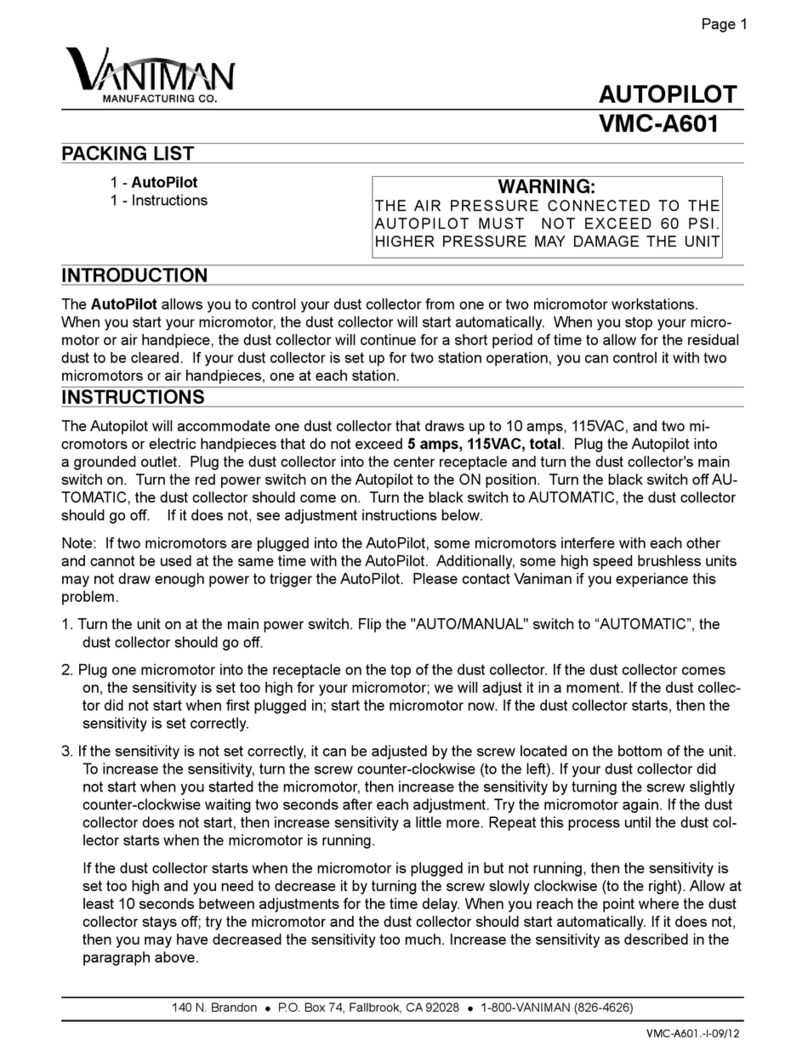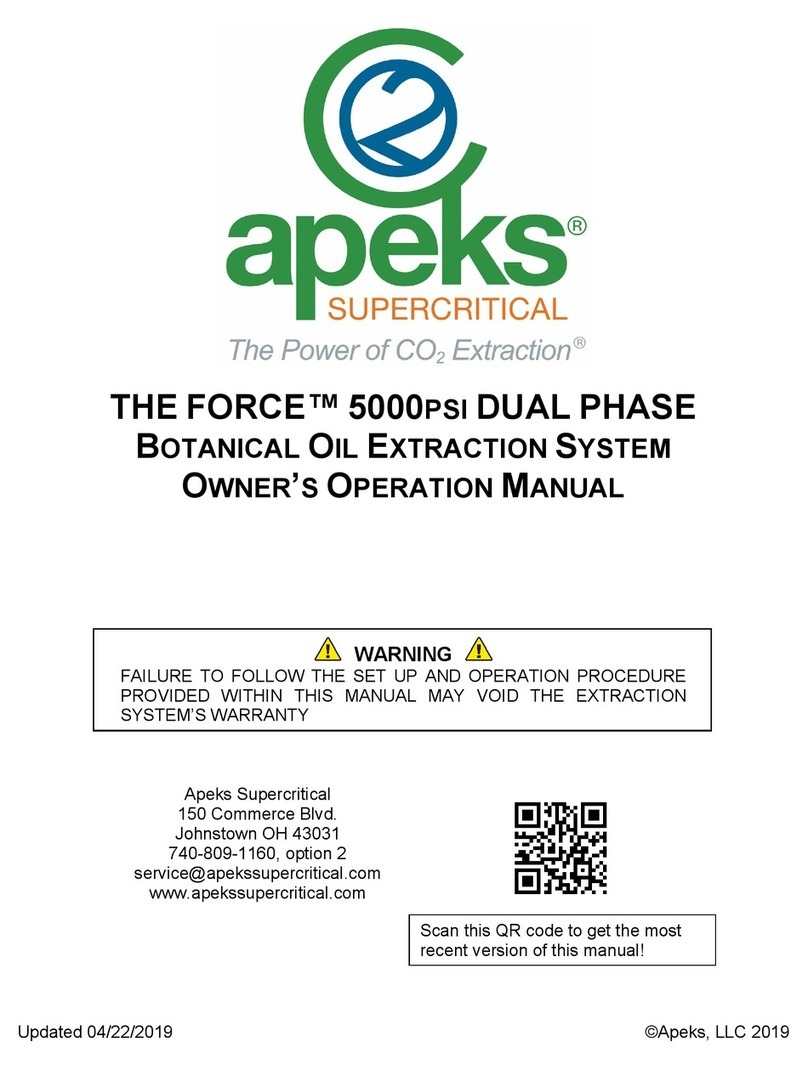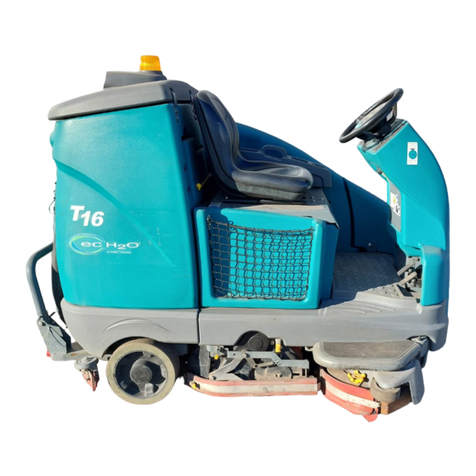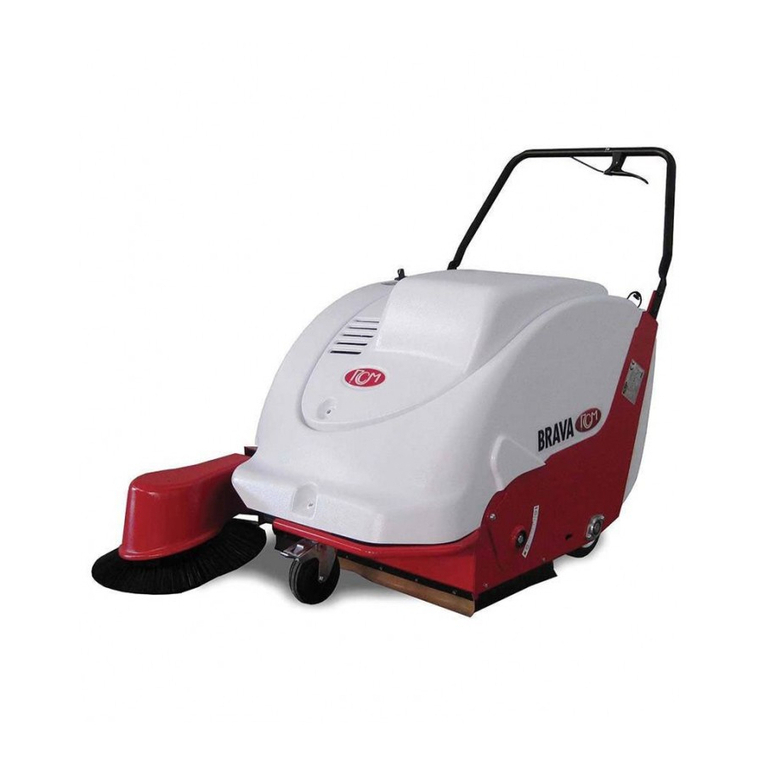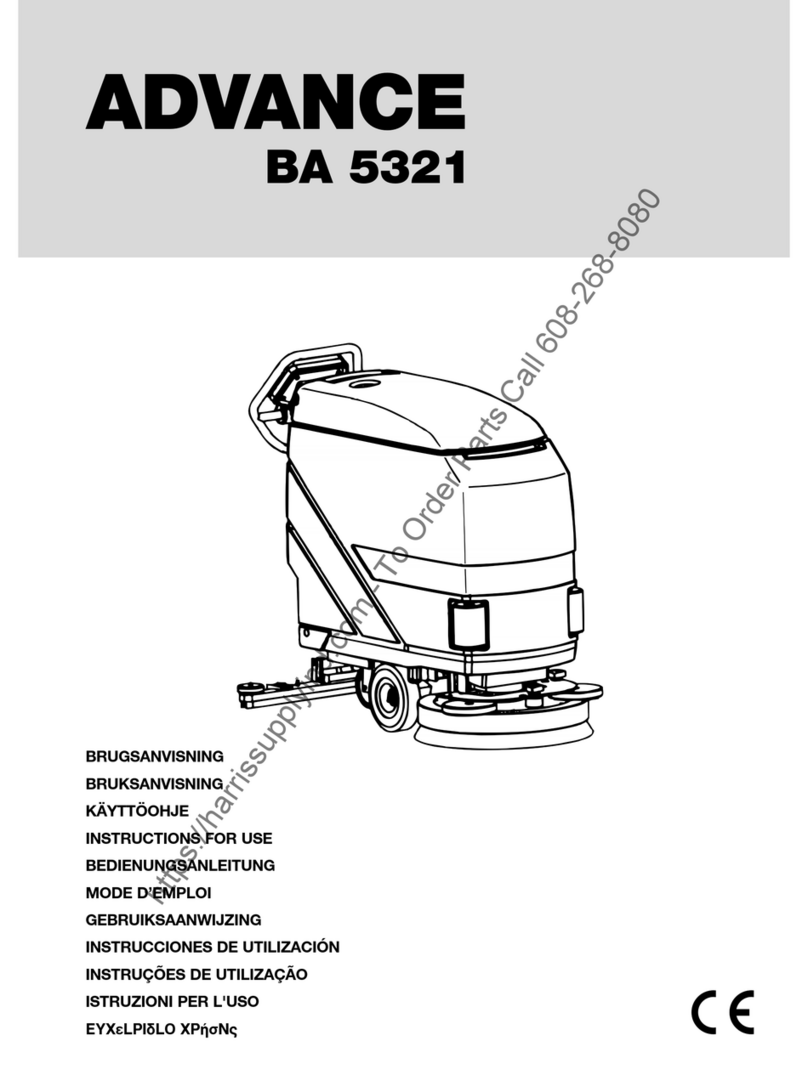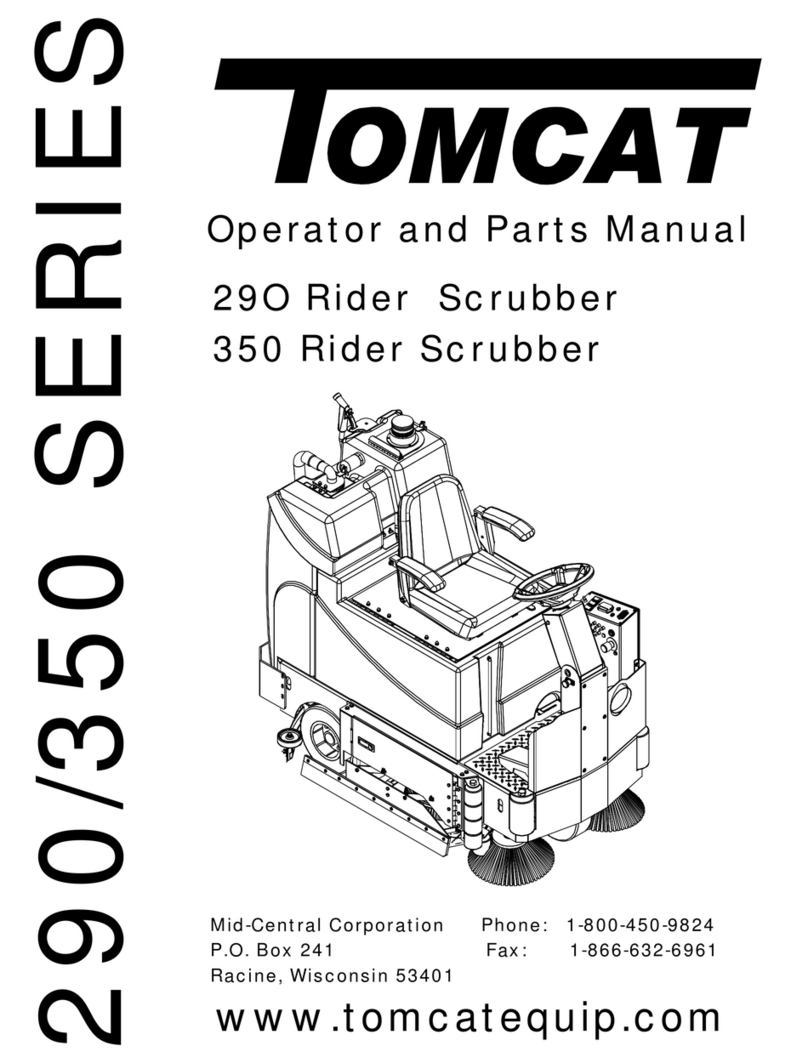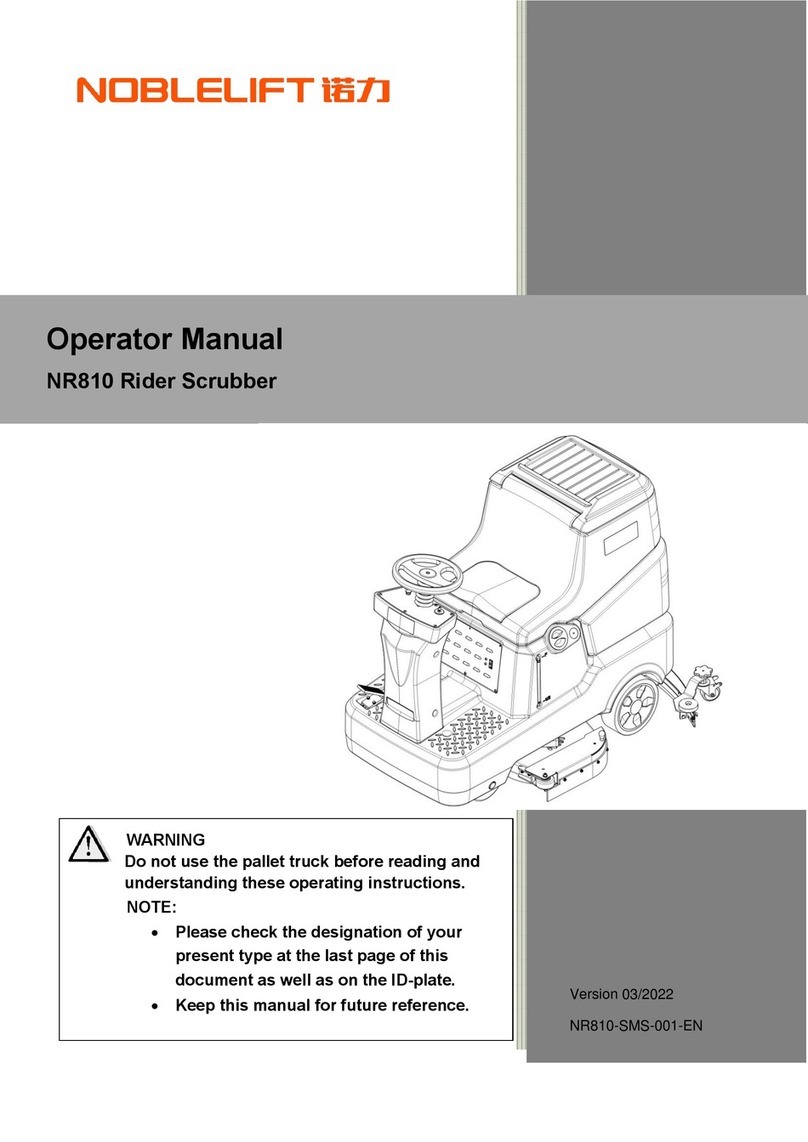CHANCEE K68 User manual

Anhui Chancee Technology Co., Ltd.
Direc�on: 11 Qiaowan Road, Heifei, Anhui, China
Website: www.chanceeglobal.com

We explore safer, higher-end and more user-friendly cleaning equipment through technical advantage and idea innovation.
Preface
This instruction manual contains all the information that you need to use and maintain the machine. Please read it carefully before
getting started.
This instruction manual is an important part of the product and should be kept together with the machine.
In order to ensure your safety, the following instructions must be followed when operating the machine and performing
maintenance:
Do NOT use the machine after drinking or taking medicine.
Turn off the machine before any maintenance or repair.
The machine can only be used by trained and competent personnel; children and disabled people are forbidden to use it.
Keep the batteries away from sparks, flame and smoke.
Do NOT use the machine in places with flammable or explosive liquids, gases and vapor.
When operating the machine, do NOT wear loose clothing, and keep you body away from the moving parts of the machine.
Do NOT smoke when charging the batteries.
In the event of a fire, use a powder extinguisher instead of water.
Attention must also be paid when the machine is about to be scrapped. Since some harmful substances have met the
standards, they should be sent to a specific service center for treatment.
If you have any question, complaint or suggestion, please feel free to contact us and we will be at your service with all our
knowledge and enthusiasm.
We wish you a pleasant experience with our product!

Contents
Chapter 1 General description
1/3
1.1 Suitable scenes
1.2 Overview of the product
1.3 Controlling panel and keys
1.4 List of accessories
1.5 Consumables and optional items
Chapter 2 Unloading and assembling the machine
4/5
2.1 Unloading the machine
2.2 Assembling the machine
Chapter 3 Checks and adjustments before using the machine
6/8
3.1 Check items
3.2 Adjustment items
Chapter 4 Instructions on operating the machine
9/11
4.1 Walking of the machine
4.2 Scrubbing the floor
4.3 Discharging sewage
4.4 Stopping the machine
4.5 Charging the batteries
Chapter 5 Cleaning and maintenance of the machine
12/14
5.1 Cleaning of the machine
5.2 Maintenance of the machine
Chapter 6 Storage and transportation of the machine
15
6.1 Storage of the machine
6.2 Transportation of the machine
Chapter 7 Common problems and solutions
16
Chapter 8 After-sale services
17
8.1 General description
8.2 Contents of warranty
8.3 Cases not covered in the warranty
Technical parameters & Warranty card

Chapter 1 General description
1.1 Suitable scenes
This product can be used in multiple scenes such as restaurants, schools, hospitals, factories, supermarkets and office buildings and
has a good cleaning effect on floors of epoxy, PVC, terrazzo, ceramic tile, wood and rubber.
1.2 Overview of the product
1
Steering wheel
2
Emergency stop button
3
Controlling panel
4
Sewage tank cover
5
Sewage tank
6
Seat
7
Clean water inlet
8
Clean water tank
9
Clean water outlet
10
Sewage discharging pipe
11
Suction pipe
12
Squeegee
13
Squeegee lifting handle
14
General switch
15
Brush plate lifting handle
16
Accelerating pedal
17
Clean water level gauge
18
Filter
19
Anti-collision wheel
20
Brush plate
1.3 Controlling panel and buttons
1
Power display screen
4
Loudspeaker button
7
Charging port
2
Forward/backward button
5
Emergency stop button
8
General switch
3
Indicator light
6
Squeegee lifting handle
9
Brush plate lifting handle

1.4 List of accessories
When you receive the product, check whether all of the following items are presented. If there is any loss, contact the seller immediately.
Item
Number
Item
Number
Item
Number
Item
Number
Scrubber
1
Squeegee
1
Instruction manual
1
Spare fuses
2
Charger
1
Tool box
2
Warranty card
1
1.5 Consumables and optional items
Consumables refer to accessories that become worn gradually and need to be replaced when they cannot work normally.
You can purchase consumables and optional accessories from the original manufacturer.
Consumables
Optional items
Brush plate
Scouring pad (red)
Needle plate
Scouring pad (black)
Squeegee strip
Scouring pad (white)
Scouring pad (red)
Scouring pad (white)
Needle plate
Scouring pad (black)
Chapter 2 Unloading and assembling the machine
2.1 Unloading the machine
Remove the packing carefully to avoid damaging the machine.
We recommend that you keep the packing of the product because it can be used again if you need to repair or transport the
machine.
Do NOT unload or unpack the machine violently.
2.2 Assembling the machine
2.2.1 Installing the squeegee
Use the squeegee lifting handle to put down the plastic squeegee holder.
Pass the squeegee fixing screws through the holes of the squeegee holder, and tighten them with plastic knobs.
Install the sewage discharging pipe.

2.2.2 Connecting the battery cords
Open the sewage tank and check whether all the cables on the batteries are connected and tightened.
Connect the battery poles. Pay attention to the polarity.
Close the sewage tank.
Chapter 3 Checks and adjustments before using the machine
3.1 Check items
3.1.1 Checking the water volume in the clean water tank
Make sure that there is sufficient water in the clean water tank before work. Do NOT do
the cleaning without enough water, or dust may be sucked into the suction motor leading
to loud noise and low working efficiency.
3.1.2 Checking the water level in the sewage tank
Pay special attention to the water level in the sewage tank. When the floating balls are in
the highest position, discharge the sewage tank immediately or the suction motor will be
burnt.
3.1.3 Checking the voltage of the batteries
When the general switch is turned on, the current voltage of the batteries will be
displayed on the voltmeter. If the last bar of the voltmeter is flashing, the power is
insufficient and please charge the batteries immediately.
Note that deep discharging (e.g. frequently using the machine when the voltage is lower
than 21 V) will reduce the service life of the batteries.

3.1.4 Checking the degree of wear of the brush plate
Check whether the brush plate is worn. If so, adjust the height of the brush plate or replace it.
3.1.5 Checking the degree of wear of the strip
The strip needs to be replaced if:
the strip cannot touch the ground when the squeegee is put down, or
the strip is cracked.
3.2 Adjustment items
3.2.1 Adjustment of the squeegee holder
Use the nuts on the universal wheels to lift or lower the squeegee holder.
3.2.2 Adjustment of the squeegee holder
Put down the squeegee holder to see whether the strip touches the ground.
Push the machine gently to see whether the strip is slightly bent and leaves no gap between itself and the ground.
If there is any gap between the strip and the ground or the strip is pressed too tight, use the universal wheels on the squeegee
holder to adjust its position.

Chapter 4 Instructions on operating the machine
4.1 Walking of the machine
Turn on the general switch.
Turn the forward/backward button to the forward gear and step on the accelerating pedal, and then the machine will move forward.
Turn the forward/backward button to the backward gear and step on the accelerating pedal, and then the machine will move backward.
If you need to stop the machine, just release the accelerating pedal so that the electromagnetic brake will work automatically
and the machine will be stopped.
Note: when the machine is moving backward or needs to be transported, make sure that the brush plate and the squeegee
are lifted, or the brush plate will be worn and the squeegee will be deformed.
4.2 Scrubbing the floor
Put down the brush plate and the squeegee.
Turn on the general switch.
Press the brush plate button and the suction motor button.
Turn the forward/backward button to the front gear, hold the steering wheel, step on the accelerating pedal and drive the
machine smoothly.
Note:
When the brush plate motor is turned on, do NOT leave the machine in the same place for a long time, because this would
leave unnecessary marks on the ground.
4.3 Discharging sewage
Before discharging the sewage tank, stop the machine and turn off the general switch.
Put down the sewage discharging pipe, open the cap and discharge the sewage.
Use clean water to wash the sewage tank.
4.4 Stopping the machine
When the work is finished, turn off the brush plate button and lift the brush plate.
Turn off the suction motor and lift the squeegee.
Discharge the sewage tank.
Move the machine to an appropriate storage place.
Turn off the general switch and remove the key.
Note: if the machine is not about to be used for a long time, please fully charge the batteries, disconnect the battery cords to
avoid power loss.

4.5 Charging the batteries
Note: the machine is powered by two 12 V maintenance-free lead-acid batteries and the total system voltage is 24 V.
The total voltage of the batteries will gradually decrease during the work. When the last bar of the voltmeter is flashing, the
machine is running out of power and charge the batteries immediately.
When maintaining the batteries, please wear gloves to avoid contact with acid substances.
Check whether the battery cords are worn and the connecting parts are loose, and replace them when necessary.
Keep the batteries dry and clean and make sure that there are no dust on them, since it is extremely harmful to the batteries
and may even cause them to burn in severe cases. Do NOT put any object (especially metallic object) on the batteries either.
In order to extend the service life of the batteries, charge them immediately when the cleaning work is finished. Deep
discharging is strictly forbidden for it will reduce their capacity and service life.
The correct steps of charging the batteries: first install the batteries, then connect them to the mains.
If the machine is not about to be used within a long period of time, please fully charge the batteries and disconnect the battery
cords.
Chapter 5 Cleaning and maintenance of the machine
Regular maintenance can extend the service life of your machine.
5.1 Cleaning of the machine
Check the wheels regularly and remove entanglements.
Clean the sewage tank and the sewage discharging pipe with clean water regularly.
Clean the filter of the water valve. If there are impurities in its transparent cover, unscrew the filter and wash the cover
and the filter screen repeatedly.
Alert: do NOT wash the machine body with water directly, since it is NOT strictly water-proof and may be short-circuited or
burnt in this case.
5.2 Maintenance of the machine
5.2.1 Replacement of the brush plate
Park the machine on the flat ground and put down the brush plate.
Rotate the plastic handle counterclockwise to remove the brush.
Grab the bristles, lift the brush plate slightly and shake it from side to side, and then the brush plate will be removed.

When installing the new brush plate, make sure that the flange plate is aligned with the holes on the brush plate, and rotate it
in any direction to finish the installation.
Installation of the needle plate: add a scouring pad on the bottom of the needle plate, and install it following the instructions
above. You can purchase needle plates and scouring pads from the original manufacturer.
The scouring pad must be soaked in water for 10-15 minutes before use, otherwise it will damage the ground.
5.2.2 Replacement of the strip of the squeegee
Park the machine on the flat ground and make sure that it is powered-off.
Use the squeegee lifting handle to put down the squeegee and screw the plastic handle counterclockwise to remove the
squeegee holder.
Unscrew the nuts of the squeegee holder and remove its bottom plate; remove the front and rear strips of the squeegee.
Install the new strips.

Chapter 6 Storage and transportation of the machine
6.1 Storage of the machine
If you do not need to use the machine for a long time, please remove and wash the squeegee and the brush plate, and store
them in a dry clean place. We recommend that you store them in an airtight plastic container.
Make sure that the water tanks are discharged and cleaned.
Charge the battery before storing the machine. If you do not use the machine for a long time, charge the battery regularly (at
least once a month) to make sure that it has enough power.
6.2 Transportation of the machine
When lifting or lowering the machine, make sure that it is in a stable position to prevent it from tipping over or falling.
When the machine leaves the factory, it is fixed on a wooden pallet and carried on a transport vehicle with appropriate
equipment; upon arrival at the destination, the same equipment must be used for loading and unloading.
When using a forklift to move the machine, it must be handled together with the packing; avoid the machine from tipping over
or falling during the operation.
Chapter 7 Common problems and solutions
The batteries cannot be charged.
The charger fails.
Replace the charger.
The charging port is oxidized.
The suction motor does not work.
The fuse is blown.
Replace the fuse.
The brush plate motor does not work.
The fuse is blown.
Replace the fuse.
No water outlet is produced.
The clean water pipe is blocked.
Clean the water pipe.
There are impurities in the filter cover.
Clean the filter cover.
The electromagnetic valve fails.
Check the electromagnetic valve.
Loud noise is produced.
The squeegee is in the wrong position.
Adjust the height of the universal
wheels of the squeegee.
The suction motor is broken.
Replace the suction motor.
The brush plate
The brush plate drops often.
Improper operation.
The brush plate buckle is worn.
Replace the buckle.
The water suction efficiency is low.
The floating ball cage is blocked.
Clean the floating ball cage.
The suction pipe is blocked.
Clean the suction pipe.
The sealing of the sewage tank is cracked.
Replace the sewage tank.
The strip of the squeegee is cracked.
Replace the strip.
Alert!

Chapter 8 After-sale services
8.1 General description
Seven-day guaranteed return, fifteen-day guaranteed replacement, one-year warranty for the whole machine, 6-month
warranty for damaged parts, and no warranty for consumables (calculated from the next day after receiving the machine).
The delivery receipt and purchase invoice are certificates for warranty and must be kept properly.
8.2 Contents of warranty
Category Contents Warranty period
The entire machine 1 year
Damaged
parts
Fuses, universal wheels, electromagnetic
valve, flange buckles, filter 6 months
Consumables Brush plate, scouring pad, needle plate,
sealing strip No warranty
8.3 Cases not covered in the warranty
The operator fails to perform maintenance according to the instruction manual, resulting in damage or failure.
The surface and/or the structure of the machine are obviously damaged due to improper operation.
Disassembly or modification not approved by the original manufacturer.
Damage due to weather or force majeure.
The warranty is expired or the machine has been used for more than 1,500 hours.
Technical parameters
Category Parameter Category Parameter
Cleaning width 3.650 m2/h Driving motor 500 W
Brush plate width 21 inches Clean water tank capacity 70 L
Squeegee width 1.000 mm Sewage tank capacity 65 L
Cleaning width 530 mm Battery capacity 24 V/100 Ah
Walking speed Working tim6-8 km/h e 3-4 h
Brush plate motor 550 W Total weight 175 kg
Suction motor 500 W Product size 1.300 * 1 . 0 0 0 * 1.100 mm

Warranty Card
用户名
User’s name
联系电话
Tel
通讯地址
Address
票据号
Bill No.
购买时间
Date of purchase
机身编号
Serial number
产品型号
Type of product
日期
Date
更换配件:
Accessories to be replaced:
故障描述:
Fault description:
Table of contents
Other CHANCEE Scrubber manuals

